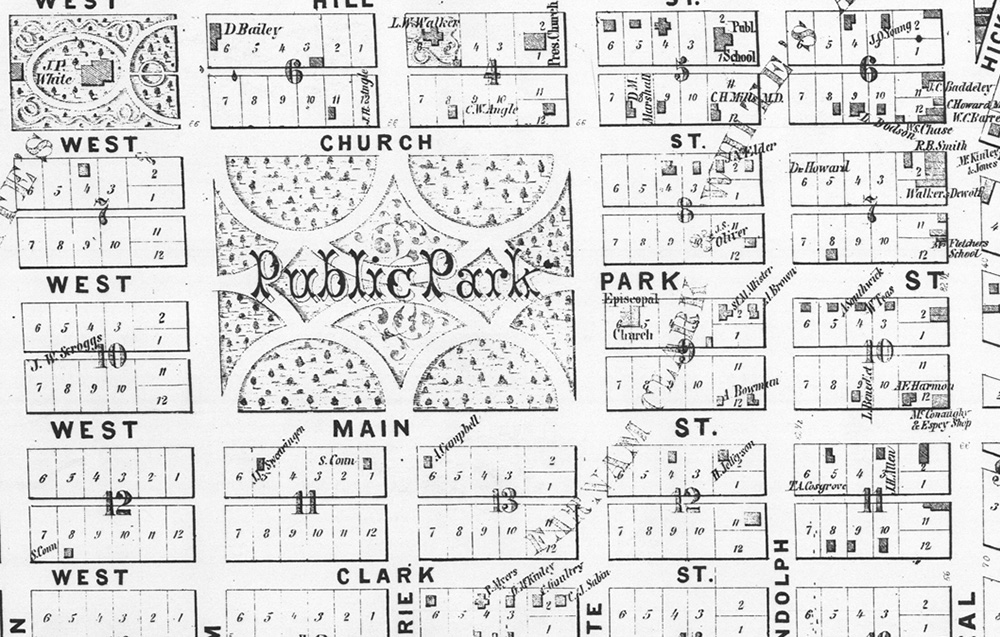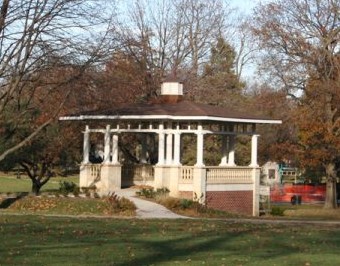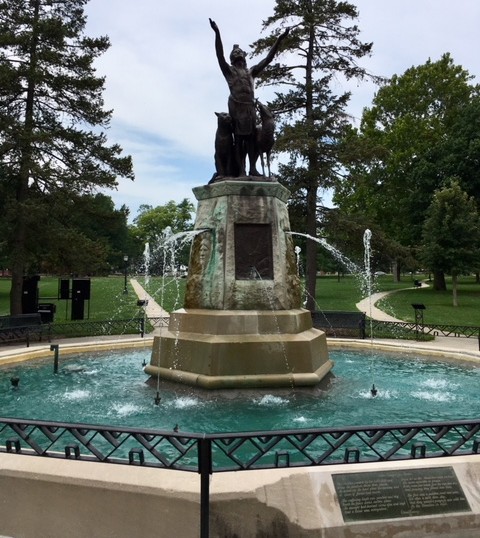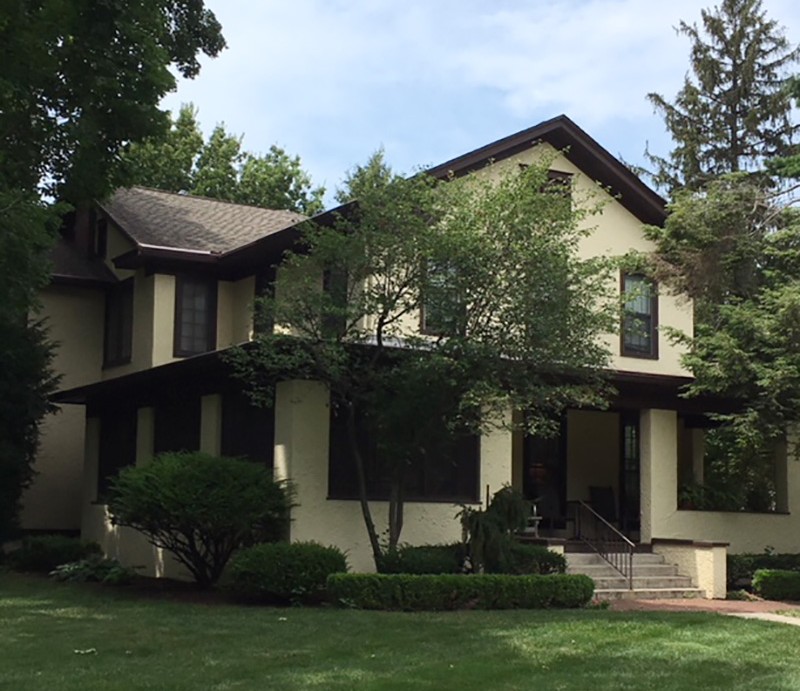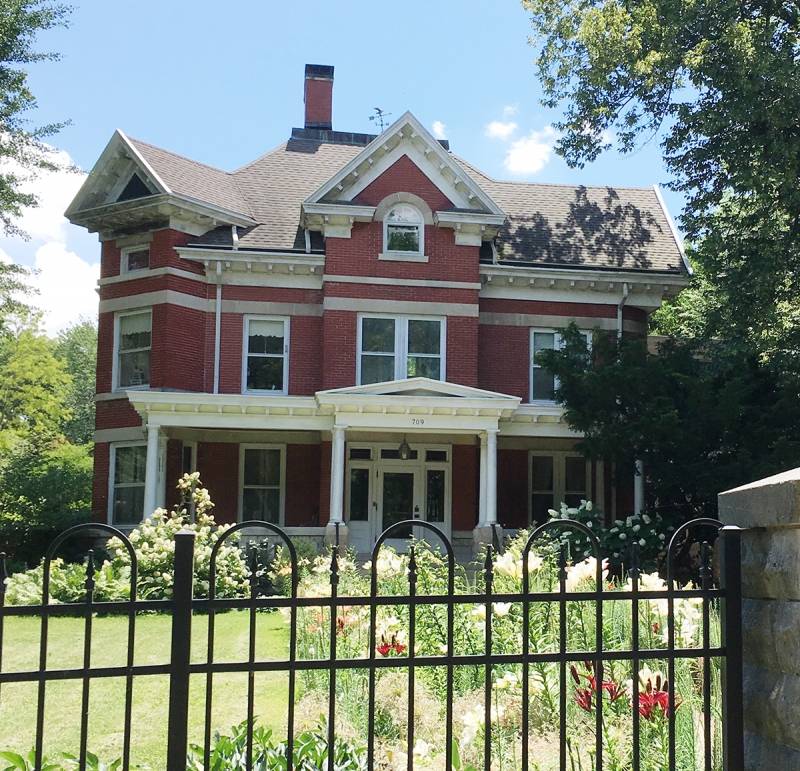This concluding installment of “Historic Sites Re-visited” brings us to the final pages of the 1976 booklet, Historic Sites of Champaign County, devoted mostly to landmark homes located either adjacent to or mere blocks away from West Side Park (itself designated as Site #71).
This space was originally called White Park after John P. White, who donated the land in 1854. It began as a platted public square, with hopes of one day being a new courthouse site, before becoming the first public park in Champaign County. Trees and shrubs originally planted throughout the park’s 12. 5 acres were said to suffer “from the depredations of townsfolk who removed many of them to their own property.”
A bandstand constructed in 1854 fared better, lasting more than a century and hosting many important civic events, including a 1912 presidential campaign speech by “Bull Moose” candidate Theodore Roosevelt. In a state of serious decline by 1964, it was subsequently demolished. The current bandstand, built on the original site and in a similar architectural style, was dedicated in 2008.
The park’s most familiar feature, the “Pray for Rain” fountain (right), was built with funds donated in 1894 by Benjamin F. Johnson “for the beautification of the park.” It was designed by Edward Kemeys, who created several artistic works for the 1893 World’s Columbian Exposition in Chicago.
Many other points of interest in the park are described and pictured on the Champaign Park District website.
Just across Elm Street west of the park are two historic homes, the Trevett House (101 N. Elm, below left) and the Mattis House (201 N. Elm, below right). Now the Owens and the Heath & Vaughn Funeral Homes, these grand buildings still embrace their “Historic Sites” status with the original signage (Sites #72 & 73). They are also historically connected, having been built by business partners.
J. R. Trevett and Ross Mattis founded the Trevett-Mattis Banking Company in 1860. This institution later became the Bank of Illinois, then ultimately BankIllinois after a merger with Champaign National Bank in the mid-1990s. The façade of the old bank at 112 W. Church Street was preserved when the building was demolished in 2007 to make way for the M2 Building. Project developers painstakingly dismantled the façade and then reintegrated it into the new structure, where it can still be seen today.
Mattis built his eloquent frame Queen Anne mansion first, in 1883. The Historic Sites book states it was “one of the first [homes in town] to be equipped with steam radiators and an elevator.” Trevett followed suit in 1900 with a brick Georgian Revival home. Its massive 17-inch brick walls “reflected the family’s concern for a fire-resistant house, [having] lost two previous homes and all of their belongings to fire.” The Trevett and Mattis mansions each hold landmark status with the City of Champaign.
Several blocks south on Elm is Site #74, designated as the Moyer House (705 S. Elm). The original 1848 three-room farmhouse at this location was surrounded by many acres of farmland. H. P. Harris operated a nursery business here in the 1870s-80s. A century later, as the surrounding land was under development, part of the property was donated to the city and became Harris Park.
The original Harris farmhouse has been extensively remodeled and considerably enlarged over the years. The present garage was originally a stable. It was built in an unusual “mortise and tenon beam construction [style] with wood-pegged structural joints” (Historic Sites). Don and Margaret Moyer moved into the home in the early 1940s and lived there for over 40 years. Moyer was a local businessman who helped found the Champaign Youth Council, the Boys Club of Champaign-Urbana (later named in his honor), and Champaign County Urban League. He served as Chairman of the Champaign Human Relations Council from its formation in 1958 until 1967. The present owners have been in the home since 1984.
Two neighboring residences on West University Avenue are the last of our designated historic sites. The Italianate mansion at 711 (right, Site #77) was called the Stipes/Kolodziej House in 1976. It appears on the 1869 birds-eye view map of Champaign and was built sometime prior by Mark Carley on land initially owned by Augustus Harmon. Cunningham’s History identifies Carley as the first to build a house “in the new Depot area.” Lawyer James B. McKinley, a one-term mayor of Champaign and a founder of the Champaign National Bank, purchased the house in 1881 and lived there until 1895.
Urbana businessman John W. Stipes, proprietor of the Sheldon Brick Company, bought the house in 1903 and lived there until 1950. Afterward it became the home of Helen Bess Cone, a prominent local interior designer who served on the design committee for the 1973 renovation of Governor’s mansion in Springfield. Cone was also part of the Trevett banking family and served on the Bank of Illinois board. The present owners (the Kolodziejs) purchased the home in 1972.
Our final stop is the Wilbur Mansion, next door at 709 (Site #78, right). Robert Sloane Wilbur and his wife Elizabeth came to Champaign from New York in the 1860s. They built this home between 1903-1907 for their daughter, Ella, who married in 1913 and lived in the house until the 1930s. Afterwards it was the home of Charles M. Thompson, Dean of the College of Commerce & Business Administration (1919-1943) at the University of Illinois.
The mansion contains four fireplaces and a third-floor ballroom, leaded-glass windows, and a carriage entrance. Formal gardens in the rear once extended clear to Clark St Beginning in 1974 the Wilbur Mansion was the home of the Champaign County History Museum. The museum sold the property in 1977 to the current residents and later moved to its present Cattle Bank location.
I hope you’ve enjoyed this series revisiting the places designated as official Historic Sites in Champaign and Urbana by the Champaign County Bicentennial Committee in 1976. It was originally published in the Smile Politely online magazine in the summer of 2020. Some revisions have been made in this updated edition, along with some additional material.

